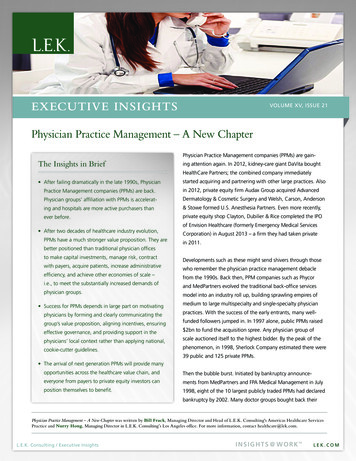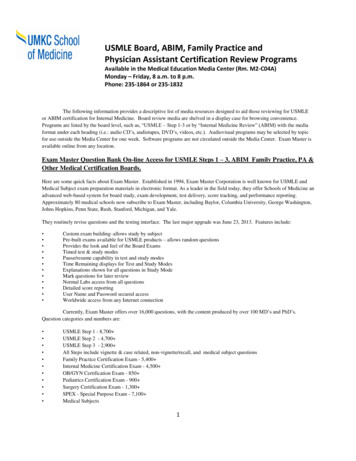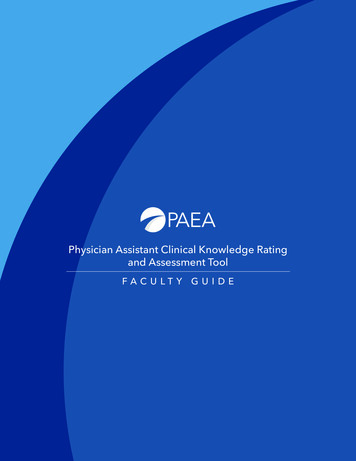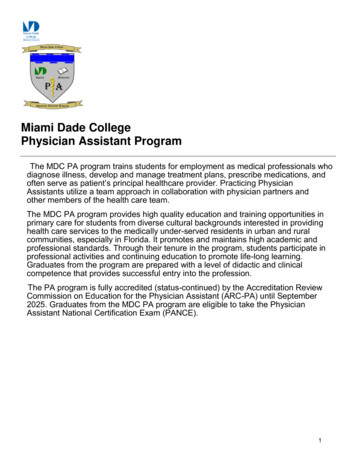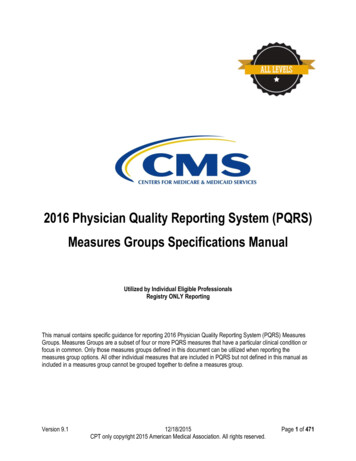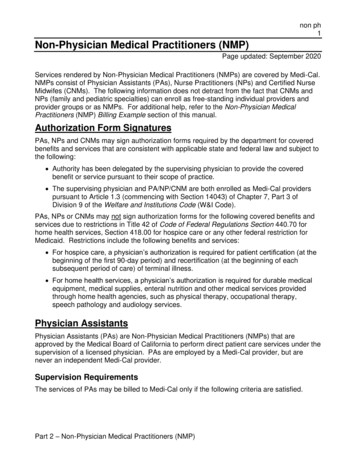
Transcription
The Physician’s Guideto Selling a Medical PracticeSteven Mansfield Shaber, JDKim L. Bayless, JDMichael Slipsky, JDPoyner Spruill LLP
The Physician’s Guide toSelling a Medical PracticeSteven Mansfield Shaber, JDKim L. Bayless, JDMichael Slipsky, JDPoyner Spruill LLPIntroductionLawyers who frequently help physicians sell or merge their practices come to discoverthese transactions are almost always the most significant financial event in their clients’professional lives, and among the most significant events in their personal lives. Thisarticle and the accompanying checklist of steps to take will help physicians analyze andprepare for the sale or merger of their practice. The article and list are notcomprehensive guidance, nor are they legal advice to the reader, and other professionals,such as accountants or brokers, would probably explain things somewhat differently.But we hope this is a useful start for physicians who are thinking about one of the mostimportant things they will ever do.The theme of this article is simply this: Put your house in order before you start to sell.A seller needs to be well organized and knowledgeable in order to avoidembarrassment, surprise, delay, mistake, and perhaps even the loss of a sale. In thephysician’s own terms, getting organized is rather like following protocols and meetingthe standard of care. It is the best thing to do in its own right, and it puts the physicianin the best position to succeed.Why Sell Or Merge?A physician practice is different from most small businesses. It is intensely personal, andits revenue comes from the physician’s knowledge, skill, reputation, and personality,none of which is really transferrable to the next owner. Consequently, a physician whosells or merges a practice is often not selling in order to retire, but is, instead, selling inPage 1 of 7
mid-career, when his or her value is highest, in order to change the way he or shepractices. The reasons for selling at this time include access to better professionalresources and administrative support, greater power vis a vis payors, the prospect ofinternal referrals from within the new organization, greater stability in the face of healthreform, and a better balance between professional life and personal life.Whatever a physician’s initial reasons might be for considering a sale, no physicianshould ever decide to sell unless he or she has identified the specific goals of the sale.You cannot assess the costs you have to pay, and you cannot negotiate a good deal,unless you know exactly what you want out of the sale. Also, you cannot know if yourco-owners will join in a sale or thwart it, unless you understand what you want anddecide if your goals and theirs are compatible.This article is written primarily from the point of view of the seller who expects to go towork for the buyer. Of course, most of the considerations also apply to a physician whois selling in order to move or retire. Finally, although this is not its main purpose, muchof this article may also help a physician-buyer think about how to acquire a practice.Who Is Buying?Here are some common buyers:1. A new physician taking over the seller’s practice.2. A small group seeking to grow in the same medical specialty or a relatedspecialty.3. A mid-sized or large group seeking to acquire patients, spread overhead, ormove into a new geographic area.4. A large specialty group entering a new market, for example kidney dialysis,radiation oncology, or anesthesia.5. A hospital or healthcare system.Note that we have not mentioned one doctor selling to his or her existing co-owners.That particular transaction should be fully covered by the buy-sell agreement among allthe physician-owners of the group.Page 2 of 7
Who Is Helping To Sell?As soon as a physician decides to seriously consider selling, that is the time to begin toput together a team of advisors. There are at least two reasons to believe that aprofessional team will be necessary. One is that the physician may not have muchexperience in selling a business. A second is that the physician may not have the timeor temperament to get involved in negotiating the details of a good deal.A seller’s team will probably come together over time, but eventually it may need toinclude an attorney, an accountant, a health care consultant, an appraiser, and/or abroker. Any one of these is probably qualified to guide the physician in the early stagesof planning, but well before the sale closes, the seller will need at least two or three ofthem to handle all the parts of the transaction.Selecting good advisors is not hard, but it requires careful attention. Education,experience and reputation are keys. So is your impression of your ability to work witheach potential advisor. Beyond that, keep in mind that the broker may have thegreatest self-interest in pushing a sale through. Also keep in mind that most businesslawyers, accountants, and appraisers do not have much experience in health care, andthat there is no threshold of education or experience to qualify someone as a healthcare consultant. In light of all this, the seller needs to investigate and interview alladvisors carefully and put together a team suited to the seller’s objectives.Who Needs To Be On-Board With The Sale?In a small practice with several physician owners, each one typically owns an equalshare. At the same time, there are often special arrangements that have to be kept inmind. For example, the senior owner may have a veto over some decisions. Or somebut not all the practice’s owners may separately own the office the practice leases. Or,as yet another example, if one owner prefers to leave and work alone instead of sellingand working for the buyer, a non-competition agreement might complicate thesituation. With so many variables, it is important to reach consensus among all theowners before beginning the process of selling.At some point, it will also be important to involve any key managers or employees,keeping in mind that they will be very concerned about how the sale will affect them.Page 3 of 7
Timing the decision to notify and involve key staff is important and difficult. It musttake into account the personalities of the staff members and their personal situations.Finally, third-party contractors such as a management company or landlord maysometimes need to be involved early in planning the possible sale of a practice.What Is For Sale?There are three ways to sell a practice. First, you can sell the entire practice by selling itsstock, if it is a professional corporation, or by selling its membership interests, if it is aprofessional limited liability company. In either case, the buyer acquires the assets andthe liabilities, and the company that is sold continues to exist and is operated by thebuyers. Second, you can sell some or all of the practice’s assets while you (the seller)continue to own the stripped-down version of your original company. In such an assetsale, the buyer acquires only the assets, and the liabilities stay with the seller, who willstill have to pay them. This, of course, makes an asset sale especially attractive tobuyers, but less so to sellers. Finally, the seller can merge his or her practice into thebuyer’s practice so that the seller’s company disappears, while the buyer’s companycontinues in business with the combined assets and liabilities of both original practices.If two small physician practices want to combine into one, which will employ all thephysicians, the buyers and sellers alike, merger may be an option.No matter the form of the sale, several kinds of assets typically go to the buyer: tangibleassets such as land, buildings, and equipment; cash and equivalents such as money inthe bank and accounts receivable; and intangibles, principally good will. In medicalpractices, tangible assets are often owned by a separate entity, such as a regular limitedliability company, and leased to the practice. If a separate entity owns the real estate orexpensive medical equipment, then it may be a second seller in the transaction. In anyevent, the seller needs to be clear with the buyer about exactly what can be and is beingsold.What Is The Price?Early on, the sellers need to calculate the price for the practice. There are two reasonswhy this is important. The first is that selling physicians may decide it makes morefinancial sense to operate the existing practice than to sell it. The second is that thePage 4 of 7
sellers need to know what the practice is worth in order to negotiate with potentialbuyers.In the sale of a practice, and especially if the selling physicians will continue to practicefor the buyer, state and federal anti-kickback and anti-referral laws require that the saleprice be for fair market value without regard to the value of future referrals. This ismandatory, so it is essential to document fair market value. However, even though thesale must be for fair market value, FMV is any price within a range of reasonable prices,and the seller is free to negotiate the highest possible price within this range. Anappraiser or broker can help here, and one way for the appraiser or broker to help is toprove (not just assert, but prove) a high value for the goodwill of the practice.Goodwill is a poorly understood concept among most physicians and lawyers, and evenamong some CPAs and MBAs. But one way to look at it is to say it is the value of thepractice over and above its tangible assets (including cash, cash equivalents, and A/R).This, of course, is a bit vague, so let’s be more specific about what gives this extra valueto the practice, beyond the value of its tangible assets. A September 15, 2008, article inthe AMA’s American Medical News lists the following elements of goodwill: (i) location;(ii) payor mix, A/R, and collection rate, not as a pot of cash in hand, but as a predictorfor the practice’s financial future; (iii) competitors in the market; (iv) the practice’sreputation; and (v) the effect of the anti-kickback and anti-trust laws. Lookingspecifically at item (iv), we should add that part of the practice’s reputation is personalto the physician-owner, and while that value is real, it cannot be transferred to anyoneelse, so it is not going to be part of the goodwill value within the sale price unless theseller is going to work for the buyer.How shall a seller use these elements of goodwill? The short answer is to get the bestprice within reason, without exceeding FMV. Obviously, reasonable people can disagreeabout the value of these factors, so there is room for negotiation between a willingseller and willing buyer. But equally obviously, some estimates of goodwill are too largeor too small to be reasonable, and, therefore, are simply wrong. It is important for theseller to know early on where the reasonable price ceiling is, and the reasonable floor.Like price, payment terms are also negotiable. They can take many forms, and they canhave various tax consequences for both parties. A discussion of financing and taxes isbeyond the scope of this article, but both should be considered early in the sale process.Page 5 of 7
What Needs To Be Done After A Prospective Buyer Appears?Once there is a potential buyer in the picture, the first thing to consider is signing a nondisclosure agreement (“NDA”) between the prospective seller and buyer to insureconfidentiality throughout the talks and afterwards, whether or not there actually is asale. This NDA may or may not include a “stand still” clause requiring both parties to betrue to each another and not court other possible partners while they are talking.The NDA may be followed by a letter of intent (“LOI”), which will certainly include astand still provision and should set out the basic terms of the deal and establish a timeline to complete the parties’ investigation of one another (their “due diligence”) andeither close the sale or walk away.What Should The Seller Expect From The Buyer?Once the seller has a serious potential buyer, the process proceeds in three stages. Theyare due diligence, negotiation, and formalizing (documenting) the decisions reached. Inprinciple, these are consecutive steps, but in practice they overlap with a lot of backand-forth between the parties.During due diligence, the seller can expect the buyer to want to see the seller’s businessentity’s documents, important deeds and contracts, loan documents and securityinterests, financial statements, billing and collection results, and tax returns. The sellermay want to see some of this material from the buyer as well, especially if the seller isgoing to work for the buyer or if the buyer will pay the sale price over time out ofoperating income.Negotiations can be short or long, simple or complicated. The seller may well want toleave them in an advisor’s hands, both as a way of getting the best deal and as a way toavoid lingering irritation after the sale is complete. In any case it is essential that theseller have all the key elements of the deal in mind when the negotiations begin.Raising new matters at the last minute can be a deal-breaker.Documenting the sale is a key concern. Whatever may have been discussed andunderstood during due diligence and negotiation, the seller should assume that the finaldocuments are the only binding explanation of the deal. If they are unclear orincomplete, some important part of the sale may be unenforceable and lost to the seller.Page 6 of 7
There is a second and equally important reason to document the sale carefully andcompletely. The sale of a physician practice and any subsequent relationship betweenthe seller and the buyer must comply with the federal anti-kickback statute and Starklaw and their state equivalents. The transaction documents are essential evidence thatthe parties complied.Clearly, at this stage the seller and the buyer need to be represented by experiencedbusiness and health care lawyers. But really counsel ought to be involved much soonerin order to prevent missteps that would otherwise have to be corrected later.What Must Be Done Because This Is A Physician Practice?Because this is a physician practice, there will be other things to consider doing. It maybe necessary to store or dispose of the seller’s patient records. It may also be necessaryto notify past and present patients by letters or public media. In some cases, it may benecessary for the seller to be credentialed by new payors, hospitals, or other providerentities. All this needs to be investigated early and done in a timely way.Check ListFollowing this article is a checklist of items and topics that the parties will probably wantto examine or discuss as part of a sale.ConclusionThis article is, as we said, not comprehensive, and it is certainly not legal advice. But itshould be helpful to physicians who want to sell or buy a practice. Anyway, we hope so.This article was prepared bythe health care and business lawyersof Poyner Spruill LLPfor the North Carolina Medical SocietyCopyright Poyner Spruill LLP 2012Page 7 of 7
PHYSICIAN SELLER'S CHECKLISTResponsible PersonItems to DoI. Initial MattersA. Identify Reasons to Sell and Objectives1. Financial2. PersonalB. Select Outside Advisors1. Attorney2. Accountant3. OthersC. Identify Needed Collaborators1. Other physician-owners of seller2. Non-owner physicians of seller3. Key employees of seller4. Seller's key third-party contractorsII. Consider Potential BuyersA. Physician group1. Similar to seller2. Larger than seller3. Specialty group4. Multi-specialty groupB. Hospital or health systemIII. Compile Seller's Key DocumentsA. Articles of Incorporation or Organization1 of 5Due DateStatus & Notes
Responsible PersonB. Bylaws or Operating AgreementC. Shareholders' AgreementD. Minutes & Resolutions by ConsentE. ACO, IPA, and Similar AgreementsF. Leases: Realty and EquipmentG. Management AgreementsH. Payor ContractsI. Employment AgreementsJ. Corporate Compliance PlanK. Loan DocumentsL. Supplier & Service ContactsM. Financial StatementsN. Tax ReturnsO. Insurance PoliciesP. Intellectual Property LicensesIV. Next StepsA.B.C.D.Get Appraisal: Assets & LiabilitiesIdentify Possible BuyerSign Non-Disclosure AgreementSign Letter of IntentV. Key Issues to Resolve with BuyerA. Assess Buyer's Soundness1. Reputation2. Experience operating physician practices3. Business/professional culture4. Financial strength5. Buyer's management team6. Buyer's management agreements7. Leases & licenses2 of 5Due DateStatus & Notes
Responsible Person8. Compensation formula9. Compliance plan (if any)10. Integrity agreement (if any)11. Actual regulatory compliance12. Litigation historyB. Establish Seller's Relationship with Buyer1. Owner, employee, or independent contractor2. Compensation: FMV3. Benefits4. Work location5. Work schedule6. Professional liability insurance7. Termination of employment8. Non-competition terms9. Business/management role with buyer10. Ownership of related assetsC. Choose Form of Sale: Stock, Asset, or Merger1. Identify assets excluded from sale2. Consider tax implicationsD. Price1. Determine fair market value2. Document FMV3. Method of payment: cash, note, other4. Security for payment5. Calculate tax consequencesE. Resolve Seller's Outstanding Obligations1. Loans to retire2. Liens and security interests to terminate3. Leases & licenses to assign or terminate3 of 5Due DateStatus & Notes
Responsible Person4.5.6.7.8.Contracts to assign or cancelObligations to departing employeesCollection of accounts receivableMaintain clinical and business recordsSettle tail coverageF. Seller's Health Care Issues1. Disposition of patient charts2. Notice to patients3. Credentialing with payors4. Credentialing with hospitals, etc.5. OthersG. Seller's Employees1. Who will go to work for buyer2. On what terms3. Settle benefits for departing employeesH. Other Negotiation Issues1. Seller's fees2. Seller's covenants, reps & warranties3. Buyer's covenants, reps & warranties4. Indemnification5. Limiting seller's liabilityVI. Poison Pills for Both Seller & BuyerA. Regulatory Matters1. Pending Audits2. Stark Problems3. Anti-Kickback Problems.4. Compliance Agreement Violations5. Licensing Board Matters4 of 5Due DateStatus & Notes
Responsible Person6. Medical Staff Privileges Matters7. False Claims IssuesB. Litigation1. Professional Liability Cases2. Business Litigation Cases3. Employment CasesVII. Prepare and Review Closing Documents5 of 5Due DateStatus & Notes
The reasons for selling at this time include access to better professional resources and administrative support, greater power vis a vis payors, the prospect of internal referrals from within the n

